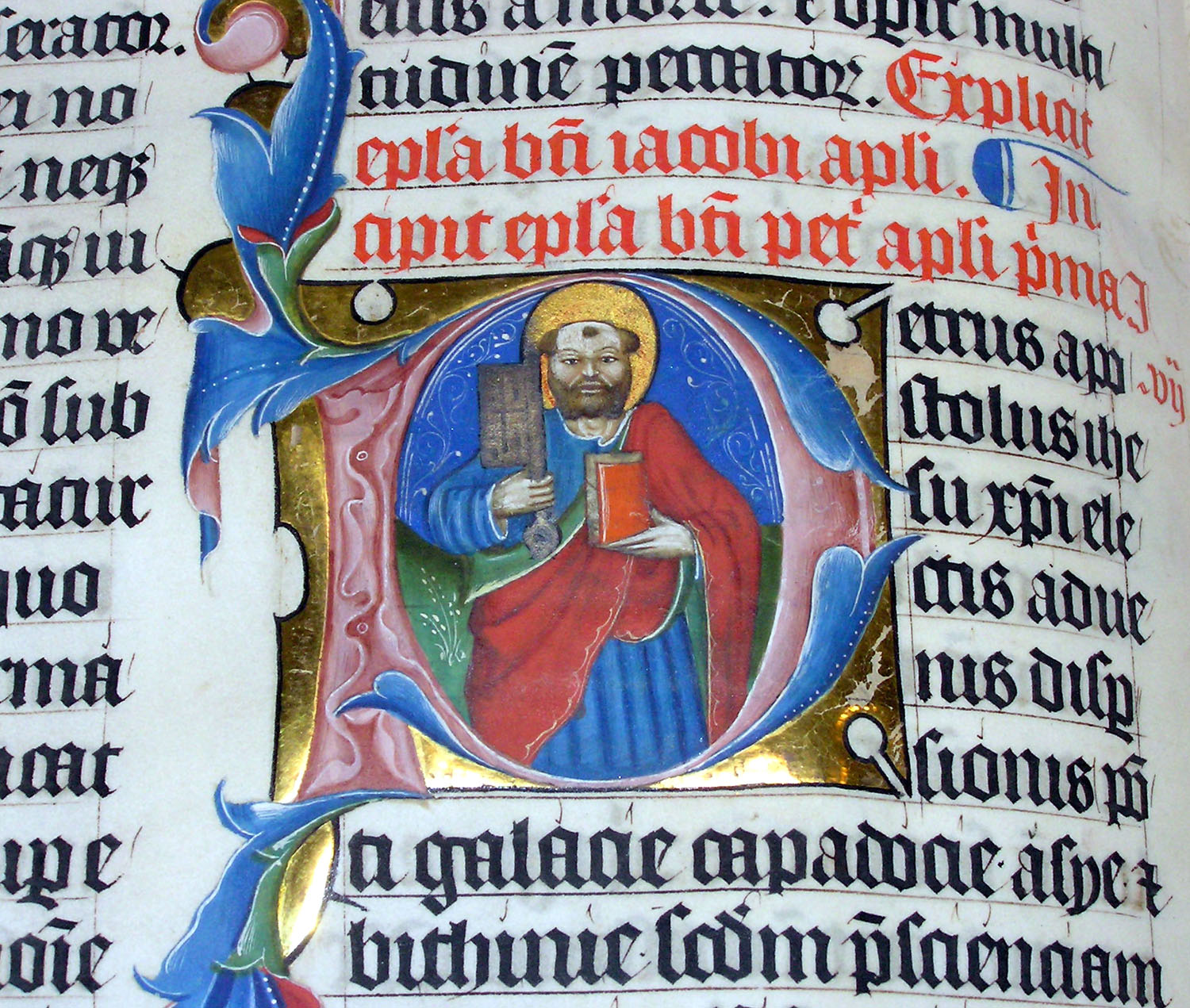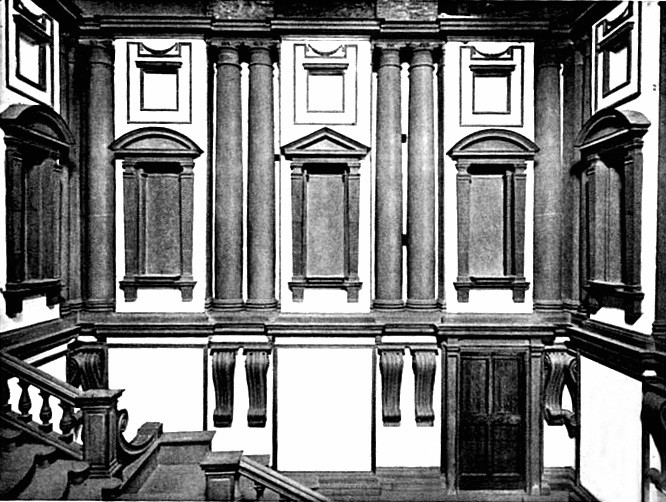|
Pluteo 29.1
Pluteo 29.1, also known as Pluteus 29.1, or simply the Florence Manuscript, is an illuminated manuscript in the Laurentian Library of Florence. The manuscript is believed to have been produced by the workshop of Johannes Grusch in Paris during the mid-thirteenth century, probably between 1245 and 1255. It contains the largest extant collection of music in the Notre Dame school, Notre-Dame style,''Scholastic Imagery in The Florence Manuscript'' by George Catalano, Essays in Medieval Studies 7, p. 41-50 retrieved 2008-06-20). mainly organum, organa, conductus, and motets. The illumination consists of thirteen historiated initials and one full-page Miniature (illuminated manuscript), miniature which serves as its Book frontispiece, frontispiece. The manuscript was issued in facsimile by Institute of Medieval Music in 1967. See also *Squarcialupi Codex References Further reading * Facsimile reproduction of the manuscript Firenze, Biblioteca mediceo-laurenziana, Pluteo 29, edi ... [...More Info...] [...Related Items...] OR: [Wikipedia] [Google] [Baidu] |
Illuminated Manuscript
An illuminated manuscript is a formally prepared document where the text is often supplemented with flourishes such as borders and miniature illustrations. Often used in the Roman Catholic Church for prayers, liturgical services and psalms, the practice continued into secular texts from the 13th century onward and typically include proclamations, enrolled bills, laws, charters, inventories and deeds. While Islamic manuscripts can also be called illuminated, and use essentially the same techniques, comparable Far Eastern and Mesoamerican works are described as ''painted''. The earliest illuminated manuscripts in existence come from the Kingdom of the Ostrogoths and the Eastern Roman Empire and date from between 400 and 600 CE. Examples include the Codex Argenteus and the Rossano Gospels, both of which are from the 6th century. The majority of extant manuscripts are from the Middle Ages, although many survive from the Renaissance, along with a very limited number from Late Antiqu ... [...More Info...] [...Related Items...] OR: [Wikipedia] [Google] [Baidu] |
Miniature (illuminated Manuscript)
A miniature (from the Latin verb ''miniare'', "to colour with ''minium''", a red lead) is a small illustration used to decorate an ancient or medieval illuminated manuscript; the simple illustrations of the early codices having been miniated or delineated with that pigment. The generally small scale of such medieval pictures has led to etymological confusion with minuteness and to its application to small paintings, especially portrait miniatures, which did however grow from the same tradition and at least initially used similar techniques. Apart from the Western, Byzantine and Armenian traditions, there is another group of Asian traditions, which is generally more illustrative in nature, and from origins in manuscript book decoration also developed into single-sheet small paintings to be kept in albums, which are also called miniatures, as the Western equivalents in watercolor and other mediums are not. These include Arabic miniatures, and their Persian, Mughal, Ottoman and ... [...More Info...] [...Related Items...] OR: [Wikipedia] [Google] [Baidu] |
Music Illuminated Manuscripts
Music is generally defined as the art of arranging sound to create some combination of form, harmony, melody, rhythm or otherwise expressive content. Exact definitions of music vary considerably around the world, though it is an aspect of all human societies, a cultural universal. While scholars agree that music is defined by a few specific elements, there is no consensus on their precise definitions. The creation of music is commonly divided into musical composition, musical improvisation, and musical performance, though the topic itself extends into academic disciplines, criticism, philosophy, and psychology. Music may be performed or improvised using a vast range of instruments, including the human voice. In some musical contexts, a performance or composition may be to some extent improvised. For instance, in Hindustani classical music, the performer plays spontaneously while following a partially defined structure and using characteristic motifs. In modal ... [...More Info...] [...Related Items...] OR: [Wikipedia] [Google] [Baidu] |
13th-century Illuminated Manuscripts
The 13th century was the century which lasted from January 1, 1201 ( MCCI) through December 31, 1300 ( MCCC) in accordance with the Julian calendar. The Mongol Empire was founded by Genghis Khan, which stretched from Eastern Asia to Eastern Europe. The conquests of Hulagu Khan and other Mongol invasions changed the course of the Muslim world, most notably the Siege of Baghdad (1258), the destruction of the House of Wisdom and the weakening of the Mamluks and Rums which, according to historians, caused the decline of the Islamic Golden Age. Other Muslim powers such as the Mali Empire and Delhi Sultanate conquered large parts of West Africa and the Indian subcontinent, while Buddhism witnessed a decline through the conquest led by Bakhtiyar Khilji. The Southern Song dynasty would begin the century as a prosperous kingdom but would eventually be invaded and annexed into the Yuan dynasty of the Mongols. The Kamakura Shogunate of Japan would be invaded by the Mongols. Goryeo resiste ... [...More Info...] [...Related Items...] OR: [Wikipedia] [Google] [Baidu] |
13th-century Books
The 13th century was the century which lasted from January 1, 1201 ( MCCI) through December 31, 1300 ( MCCC) in accordance with the Julian calendar. The Mongol Empire was founded by Genghis Khan, which stretched from Eastern Asia to Eastern Europe. The conquests of Hulagu Khan and other Mongol invasions changed the course of the Muslim world, most notably the Siege of Baghdad (1258), the destruction of the House of Wisdom and the weakening of the Mamluks and Rums which, according to historians, caused the decline of the Islamic Golden Age. Other Muslim powers such as the Mali Empire and Delhi Sultanate conquered large parts of West Africa and the Indian subcontinent, while Buddhism witnessed a decline through the conquest led by Bakhtiyar Khilji. The Southern Song dynasty would begin the century as a prosperous kingdom but would eventually be invaded and annexed into the Yuan dynasty of the Mongols. The Kamakura Shogunate of Japan would be invaded by the Mongols. Goryeo resiste ... [...More Info...] [...Related Items...] OR: [Wikipedia] [Google] [Baidu] |
Squarcialupi Codex
The Squarcialupi Codex (Florence, Biblioteca Medicea Laurenziana, Med. Pal. 87) is an illuminated manuscript compiled in Florence in the early 15th century. It is the single largest primary source of music of the 14th-century Italian ''Trecento'' (also known as the " Italian ars nova"). It consists of 216 parchment folios, organized by composer, with each composer's section beginning with a portrait of the composer richly illuminated in gold, red, blue and purple. The manuscript is in good condition, and musical pieces are complete. Included in the codex are 146 complete pieces by Francesco Landini, 37 by Bartolino da Padova, 36 by Niccolò da Perugia, 29 by Andrea da Firenze, 28 by Jacopo da Bologna, 17 by Lorenzo da Firenze, 16 by Gherardello da Firenze, 15 by Donato da Cascia, 12 pieces by Giovanni da Cascia, 6 by Vincenzo da Rimini, and smaller amounts of music by others. It contains 16 blank folios, intended for the music of Paolo da Firenze, since they are labeled as such ... [...More Info...] [...Related Items...] OR: [Wikipedia] [Google] [Baidu] |
Book Frontispiece
A frontispiece in books is a decorative or informative illustration facing a book's title page—on the left-hand, or verso, page opposite the right-hand, or recto, page. In some ancient editions or in modern luxury editions the frontispiece features thematic or allegory, allegorical elements, in others is the author's portrait that appears as the frontispiece. In medieval illuminated manuscripts, a presentation miniature showing the book or text being presented (by whom and to whom varies) was often used as a frontispiece. Origin The word comes from the French language, French ''frontispice'', which derives from the late Latin ''frontispicium'', composed of the Latin ''frons'' ('forehead') and ''specere'' ('to look at'). It was synonymous with 'metoposcopy'. In English, it was originally used as an frontispiece (architecture), architectural term, referring to the decorative facade of a building. In the 17th century, in other languages as in Italian language, Italian, the term cam ... [...More Info...] [...Related Items...] OR: [Wikipedia] [Google] [Baidu] |
Historiated Initial
A historiated initial is an initial, an enlarged letter at the beginning of a paragraph or other section of text, that contains a picture. Strictly speaking, a historiated initial depicts an identifiable figure or a specific scene, while an inhabited initial contains figures (human or animal) that are decorative only, without forming a subject. Both sorts became very common and elaborate in luxury illuminated manuscripts. These illustrated initials were first seen in the Insular art of the early 8th century. The earliest known example is in the Saint Petersburg Bede, an Insular manuscript of 731–46, and the Vespasian Psalter has another. The size and decoration of the initial further gives clues to both its importance and location. Letters that began a new section of a text or a particularly noteworthy section might receive more flourishes and space. They would also provide a visual point of reference, "marking the division of the text into books, chapters, paragraphs and som ... [...More Info...] [...Related Items...] OR: [Wikipedia] [Google] [Baidu] |
Laurentian Library
The Laurentian Library (Biblioteca Medicea Laurenziana or BML) is a historic library in Florence, Italy, containing more than 11,000 manuscripts and 4,500 early printed books. Built in a cloister of the Medicean Basilica di San Lorenzo di Firenze under the patronage of the Medici pope Clement VII, the library was built to emphasize that the Medici were no longer just merchants but members of intelligent and ecclesiastical society. It contains the manuscripts and books belonging to the private library of the Medici family. The library building is renowned for its architecture that was designed by Michelangelo and is an example of Mannerism.Fazio, Michael; Moffett, Marian; Wodehouse, Lawrence, ''Buildings across Time'' (London: Lawrence King Publishing Ltd, 2009), pp. 308–310.Lotz, Wolfgang; Howard, Deborah, ''Architecture in Italy, 1500–1600'' (New Haven: Yale University Press, 1995), pp. 91–94. All of the book-bound manuscripts in the library are identified in its ''Codex La ... [...More Info...] [...Related Items...] OR: [Wikipedia] [Google] [Baidu] |
Motet
In Western classical music, a motet is mainly a vocal musical composition, of highly diverse form and style, from high medieval music to the present. The motet was one of the pre-eminent polyphonic forms of Renaissance music. According to Margaret Bent, "a piece of music in several parts with words" is as precise a definition of the motet as will serve from the 13th to the late 16th century and beyond.Margaret Bent,The Late-Medieval Motet in ''Companion to Medieval & Renaissance Music'', edited by Tess Knighton and David Fallows, 114–19 (Berkeley, California: University of California Press, 1992): 114. . The late 13th-century theorist Johannes de Grocheo believed that the motet was "not to be celebrated in the presence of common people, because they do not notice its subtlety, nor are they delighted in hearing it, but in the presence of the educated and of those who are seeking out subtleties in the arts". Etymology In the early 20th century, it was generally believed the name ... [...More Info...] [...Related Items...] OR: [Wikipedia] [Google] [Baidu] |
Conductus
The ''conductus'' (plural: ''conducti'') was a sacred Latin song in the Middle Ages, one whose poetry and music were newly composed. It is non-liturgical since its Latin lyric borrows little from previous chants. The conductus was northern French equivalent of the ''versus'', which flourished in Aquitaine. It was originally found in the twelfth-century Aquitanian repertories. But major collections of conductus were preserved in Paris. The conductus typically includes one, two, or three voices. A small number of the conductus are for four voices. Stylistically, the conductus is a type of discant (i.e. note-against-note polyphony). Its form can be strophic or through-composed form. The genre flourished from the early twelfth century to the middle of thirteenth century. It was one of the principal types of vocal composition of the ars antiqua period of medieval music history. History Origins of the name The conductus was most likely sung while the lectionary was carried from ... [...More Info...] [...Related Items...] OR: [Wikipedia] [Google] [Baidu] |

.jpg)







